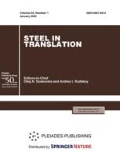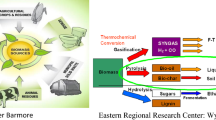Abstract
A thermodynamic analysis of carbon gasification process in the presence of moisture has been performed. The chemical process has been represented by system C–O–H with a ratio between the elements therein amounting to 1 : 1 : 2 and 1 : 2 : 2. To refine the methodology of the studies and to verify the results, a well-studied C–O subsystem has been used. The initial array of the processed data has been represented by a content of such chemical components as C, CO, CO2, CH4, H2, and H2O calculated using a Terra software package. There is no unit chemical reaction in the С–О–Н system; therefore, the entire operating temperature range from 298 to 1400 K has been divided into three characteristic subranges to analyze each of them separately. By comparing the numerical values of component content at the boundaries of the subranges, a change in the values going from one subrange to another has been determined. These values are multiples of stoichiometric coefficients for the proposed chemical reactions. Thus, the problem of establishing the type of chemical reactions has been solved. However, in two of the three subranges, the identified reactions exhibit a complicated character, that is, they contain more than four components. Therefore, we have decomposed them in the basis of three more simple reactions inherent in these thermal subranges. As a result, the total number of reaction types has been reduced to four: two main reactions of carbon gasification (С + 2H2О = СО2 + 2H2, С + СО2 = 2СО) and two reactions of methane formation and decomposition (2С + 2H2О = СН4 + СО2, СН4 = С + 2H2). At the same time, with the use of balance coefficients β, the fraction of each reaction in the general chemical process has been determined. However, the type of chemical reactions gives all the necessary information concerning the content of system components only at the boundaries of the subranges. The quantitative assessment of the chemical process in the temperature subranges can be obtained by determining the temperature dependence of the reaction coordinates ξ(Т) as a function of Gibbs energies and pressure, i.e., ξ(Т) = f [ΔrG°(T), Р]. The reaction coordinates ξ in combination with balance coefficients β make it possible to calculate not only the content of the reactants and reaction products, but also the conditional temperature values for the beginning and termination of the reactions themselves. In this case, no fitting coefficients and parameters of a fitting should be used in the calculations. The average absolute error in the quantitative description of computer simulation results for system C–O–H is less than 0.02 mol (per 1 mol of carbon), whereas for subsystem C–O it is almost zero.


Similar content being viewed by others
REFERENCES
De Donder, Th. and van Rysselbtrghe, P., Thermodynamic Theory of Affinity, Palo Alto, CA: Stanford Univ. Press, 1936.
Prigogine, I. and Defay, R., Chemical Thermodynamics, London: Longman, 1967.
Lewis, G. and Randall, M., Thermodynamics, New York: McGraw Hill, 1961.
Kondepudi, D. and Prigogine, I., Modern Thermodynamics, New York: Wiley, 2002.
Bulatov, N.K. and Lundin, A.B., Termodinamika neobratimykh fiziko-khimicheskikh protsessov (Thermodynamics of Irreversible Physical and Chemical Processes), Moscow: Khimiya, 1984.
Trusov, B.G., Database and software complex TERRA, edition 6.3.
Gurvich, L.V., Iorish, V.S., et al., IVTANTHERMO—A Thermodynamic Database and Software System for the Personal Computer: User’s Guide, Boca Raton: CRC Press, 1993.
White, W.B., Johnson, S.M., and Dantzig, G.B., Chemical equilibrium in complex mixtures, J. Chem. Phys., 1958, vol. 28, no. 5, pp. 751–755.
Brinkley, S.R., Calculation of equilibrium composition of systems of many constituents, J. Chem. Phys., 1947, vol. 15, no. 2, pp. 107–110.
Gurvich, L.V., Veitz, I.V., et al., Thermodynamic Properties of Individual Substances, in 5 vols., New York: Hemisphere, 1989, 4th ed.
Berdnikov, V.I., Computer calculation of chemical equilibrium in multicomponent systems, Izv. Vyssh. Uchebn. Zaved., Chern. Metall., 1984, no. 4, pp. 120–122.
Ryzhonkov, D.I., Arsent’ev, P.P., Yakovlev, V.V., et al., Teoriya metallurgicheskikh protsessov (Theory of Metallurgical Processes), Moscow: Metallurgiya, 1989.
Gol’dshtein, N.L., Kratkii kurs teorii metallurgicheskikh protsessov (Brief Course on Fundamentals of Metallurgical Processes), Sverdlovsk: Metallurgizdat, 1961.
Kuznetsov, Yu.S. and Kachurina, O.I., Redox properties of gas phases, Steel Transl., 2018, vol. 48, no. 1, pp. 25–33.
Korn, G. and Korn, Th., Mathematical Handbook for Scientists and Engineers, New York: McGraw-Hill, 1968.
Atkins, P. and de Paula, J., Atkins’ Physical Chemistry, Oxford: Oxford Univ. Press, 2007.
Laptev, D.M., Termodinamika metallurgicheskikh rastvorov (Thermodynamics of Metallurgical Solutions), Chelyabinsk: Metallurgiya, 1992.
Berdnikov, V.I., Adaptation of the balance thermodynamic analysis to the mechanism of silicon reduction in a ferroalloy furnace, Stal’, 1991, no. 2, pp. 42–45.
Berdnikov, V.I., Gudim, Yu.A., and Karteleva, M.I., Thermodynamic modeling of silicocalcium production based on reduction by carbon, Steel Transl., 2008, vol. 38, no. 4, pp. 275–280.
Berdnikov, V.I., Gudim, Yu.A., and Karteleva, M.I., Thermodynamic simulation of aluminum-alloy production by heating with carbon, Steel Transl., 2009, vol. 39, no. 2, pp. 111–117.
Author information
Authors and Affiliations
Corresponding author
Additional information
Translated by O. Polyakov
About this article
Cite this article
Berdnikov, V.I., Gudim, Y.A. Chemical Reactions in Carbon Gasification Processes. Steel Transl. 49, 593–600 (2019). https://doi.org/10.3103/S096709121909002X
Received:
Revised:
Accepted:
Published:
Issue Date:
DOI: https://doi.org/10.3103/S096709121909002X




